Tennis is a sport that thrives on being unpredictable. With 4 people involved instead of just 2, doubles tennis is even more so…
But that’s what makes tennis so exciting.
Playing tennis is no easy feat. Footwork, solid groundstrokes, and a game plan go a long way.
There’s a lot going on beyond serving and hitting groundstrokes – especially in doubles tennis.
In a doubles match, strategy plays a huge role.
Contents
Singles Vs. Doubles
Although both follow the rules of tennis, singles and doubles are entirely differ from one another:
- The number of tennis players: in singles matches, one player faces off against another, while in doubles tennis, it’s made up of a pair opposing another pair.
- Court width: 27 ft. for singles vs. 36 ft court in doubles
- Serve: You serve every other game in singles. In doubles, serving rotates throughout all 4 players so you serve one time in every four games.
That’s only scratching the surface.
The biggest distinction between the two is strategy.
11 Tennis Doubles Strategies To Improve Your Winning Percentage
We all have the mindset that stronger and faster players always win. Tennis is a game of skill and that remains with doubles.
But in doubles, tactics play an enormous role.
Communication, volleys, and formations all go into play. Playing with a partner requires a fair amount of teamwork, patience, communication, skills, and effort.
All of these things are what makes doubles tennis complex and so very interesting.
I’m going to start with the most foundational information and move to more complex scenarios and positioning.
#1 Positioning
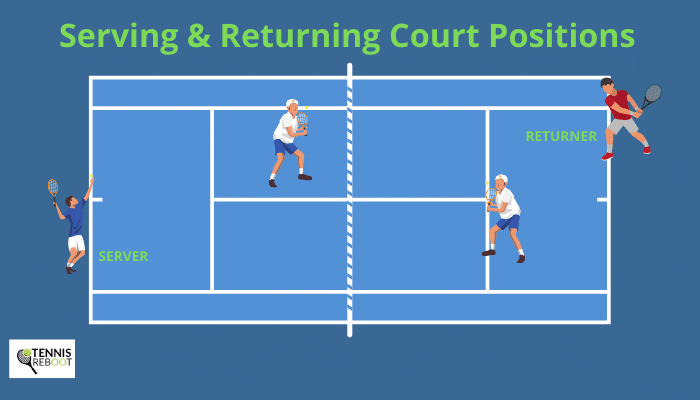
One of the first things beginners should learn is knowing where to position yourself.
In singles tennis, you’re used to covering the whole width of the court by yourself. But in doubles, the court is much bigger and wider. Each of you is responsible for half a side of the court.
You’ve got to trust your partner to handle the balls that come their way. And they have to trust you to do the same.
And it’s not any easier covering just half the court – because there’s still often uncertainty.
Between you and your partner, you have to decide who will be on the advantage court (ad side/ left side) and on the deuce (right side).
Even though you plan to cover the left or right side of the court, as a point evolves your court position may change. Who covers the right side now?
Yelling out “mine” or “yours” will save both you and your partner from watching a ball sail between the two of you with neither of you even going for it.
Tip: If both players are right-handed, usually the player with the stronger backhand will receive serve on the advantage/left side. For most tennis players, their backhand is their weaker groundstroke so advantages can be had by going after your opponent’s weak side on serve.
Another thing to keep in mind is timing. When to move and where to move when you’re the return team:
- During the first serve, stand at or just behind the baseline not too far from the doubles alley/singles line. This allows you to get serves that will target your forehand or backhand side.
- When returning a second serve, move closer to the net. Second serves are notoriously more slowly paced. Getting closer inside the court will allow you to capitalize on a weaker serve and potentially cut off any angles.
- If your partner is the one receiving a serve, stand near the service line in the opposite court. Doing so cuts off the court from an angled volley from the opposing net player.
- If your partner is serving, stand in the center of the service box opposite the opponent’s returner. This puts you in a good position to volley a weak return from the returner.
When it comes to positioning, the key is to be open to constant adjustments.
#2 Communicate with Your Partner
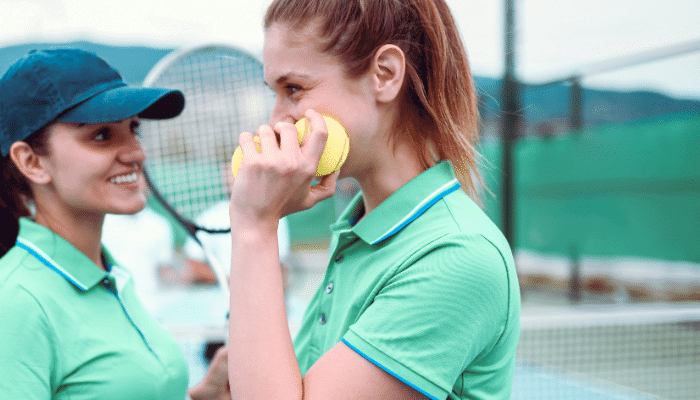
This.
Communication. Is. Everything.
Although it sounds like one of those cheesy relationship quotes, this actually has a lot of impact on the way you and your doubles partner will fare in doubles.
I can’t stress this enough.
Doubles Tennis is a team sport.
It won’t matter if you’re a very skilled tennis player individually. If you can’t work together, your chances of success are diminished.
In doubles tennis, communication is key. Direction, strategy, formations, and net play should be clear between you and your partner.
Each doubles pair should have their own way of communicating during and after the play. Some take advantage of using hand signals during a match.
As long as you’re communicating, you’ll have fun and a much higher chance of success.
#3 Play to Your Team's Strengths
Every tennis player has strengths in some areas and weaknesses in others.
If you’re the stronger server, serve first between you and your partner. If your partner has a killer backhand, have them cover the ad/left side of the court.
Doubles tennis is about the success of the team as a whole, but the team is made up of two individuals.
As a team, strategize to use your individual strengths to create opportunities for the benefit of the team.
#4 Exploit Opponents Weaknesses
Just like any other sport, exploiting an opponent’s weakness is a component of competition.
In a doubles match, you observe as you play, noting what causes your opponent the most difficulty.
When an opportunity arises, take advantage to exploit the weakness.
Don’t get the wrong idea here. I’m not suggesting blasting groundstrokes at your opponent at the net. This is more in line with the server having a weak second serve and teeing off on it when in your sweet spot.
Sportsmanship is a part of doubles tennis just like it is with singles tennis.
#5 Keep Moving
Many beginner tennis players have lead feet. It’s like inertia – an object in motion stays in motion. The same can be said about your feet.
If you’re light on your feet and almost dancing out there, you’re ready for anything that comes your way.
Tennis is a sport that relies on quick movements and decision making. It’s about constant adjustments. Footwork is key to setting up proper shots.
A lot of what happens in a doubles match happens at the net. Balls fly quickly so standing still in one place is a big no-no.
Whenever the ball is struck on court, do a split step.
It’s one tiny step, but it keeps you light on your feet and ready for the next shot.
#6 Attack the Middle of the Court
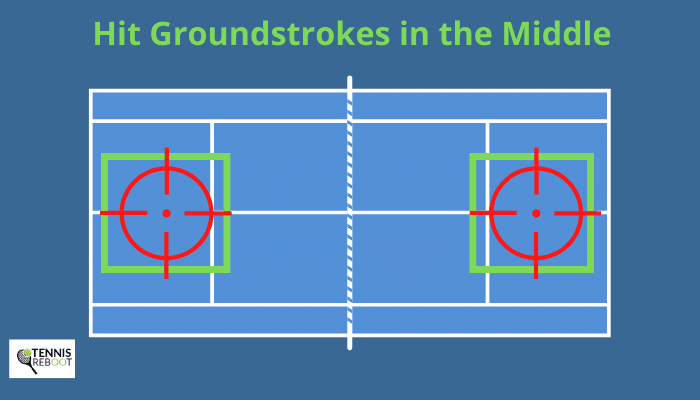
When hitting groundstrokes, don’t underestimate the power of a deep middle shot.
Hitting the ball down the middle of the court causes your opponents to wonder which player will cover the shot.
If you hit crosscourt or specifically to one side of the court, the player on that side will hit the ball. If you split the court, your opponents may take an extra second of time to figure out who will hit the shot and their chances of success are reduced.
Any time you can cause chaos to your opponents, they won’t be playing at their best due to confusion. Take advantage of any opportunity!
#7 Angles
This may seem 100% counter to #5, but this doubles tennis strategy tip is mostly suggested for volleying and overheads.
In doubles tennis, you’ve got the entire court at your disposal. Take advantage of those alleys.
When volleying or hitting overheads, use sharp angles to pull your opponents off the court.
If you can hit a well-placed shot that takes advantage of a sharp angle – go for it!
#8 Use of the Lob
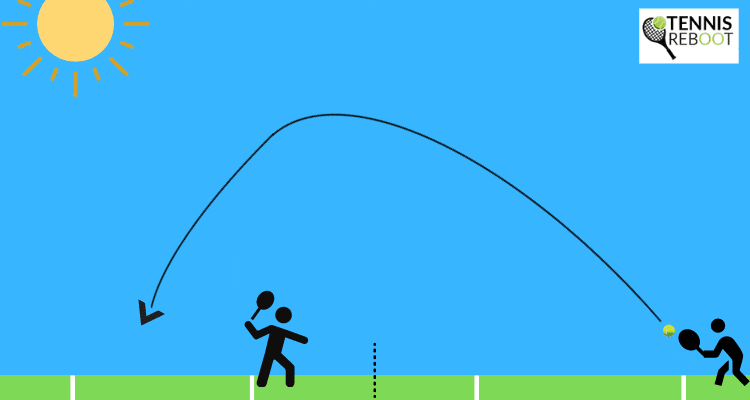
A lob is a sudden change in the ball’s speed and path. It involves taking pace off the ball and hitting it high over the players at the net into the back of the court.
To hit a lob, make sure you hit the ball as high as possible and hit it with a topspin.
Hitting a lob will likely catch your opponents off guard. It’ll have them rushing toward the back of the court giving up their net position.
Many times they don’t make it to the ball, or once it bounces the topspin takes the ball out of their reach.
The use of a lob is highly underrated in doubles tennis. They take practice to master, but it’s time well-spent.
Tip: Lobs come in handy in the middle of a long rally. Don’t be afraid to change things up and hit a lob. It can create chaos and keeps the other team on their toes.
#9 Stay Out of “No Man’s Land”
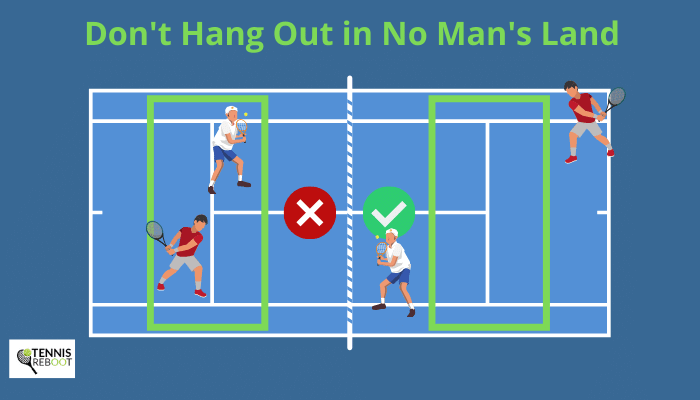
No Man’s Land is a part of the court that isn’t quite a net position and it isn’t in the back court.
It’s a spot in the middle of the court where you can be trapped and not feel like you have a lot of options.
Deep shots may bounce right at your feet and they may not be in volley range. Or you end up hitting a half volley and those are always unpredictable.
For your best tennis doubles strategies for beginners (and ALL levels), stay out of No Man’s Land.
#10 Poaching
Aside from positioning and doubles formations, a doubles player also makes use of techniques.
One tennis doubles strategy for beginners technique is poaching.
Poaching occurs by the net player when your team is serving.
Let’s walk through a scenario…
Your partner is serving and the score is 30-15. They’re serving from the ad/left side and you’re up at the net in the right service box, relatively close to the net.
When the returner makes contact with the ball, they tend to hit cross court back toward the server. The court is open since you’re at the net directly in front of the returner.
If you move to the left and cut off the return, that’s poaching.
Now you can get burned poaching if you move too early. If you telegraph that you plan on moving, the returner will attempt to hit down the line rather than crosscourt.
If you move too late, you might not make contact with the ball.
Poaching can be powerful, but it doesn’t work every time.
It’s a tool in the toolbox. Knowing you can pull it out when you want to is powerful.
#11 Formations
Formations are used to take the idea of doubles tennis strategies for beginners up a notch! Many matches are based on this tennis doubles strategy information.
When playing doubles tennis, there are a variety of formations that can be used.
Good players know how to switch strategies depending on what’s happening in the match or if one formation isn’t working out for the team.
It usually takes a bit of time to proceed through standard doubles positions, the use of poaching, and then fancy formations.
Standard Doubles
Typically, in a standard doubles tennis formation when returning serve, either you or your partner is positioned behind the baseline, while the other player acts as the net player by planting themself close to the net.
This position allows the baseline player to return the serve with the net player cutting off half the court when the ball is sent back over the net.
Standard doubles is the most common formation used in tennis doubles, but other formations exist and may be worth incorporating into your next match.
I-Formation
Now, this is where things get a little more complex.
While the standard doubles formation is simple enough, the I-formation is a bit of a twist.
The I-formation is done by the serving team with the two players on court forming something similar to the shape of the letter, I.
Both the server and partner are almost on top of the center of the court. The server stands very close to the center hash mark and the returner is almost on top of the net directly in the middle.
Example:
In the standard formation, if the server is on the ad side, the doubles partner traditionally is on the deuce side of the court up toward the net.
With the I-formation, the server stands close to the center hash mark and the net player is up at net, but crouched down below the height of the net – almost on the center service mark.
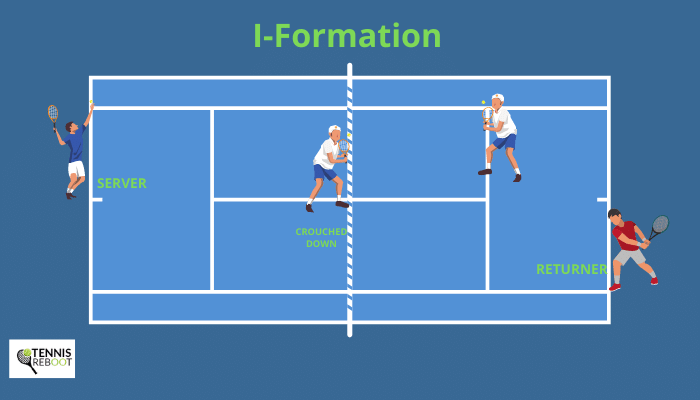
By starting the point off in the middle of the court, the serving team isn’t making it known where they’re going after the ball is served.
- Will the net player pop up and take the traditional side (deuce) when serving on the ad court?
- Will the net player stand straight up and try to take out any cross court return with a swift volley?
- Will the net player continue with the poach (move to the left) and take over the spot where the server might usually be after serving and volleying?
- Where will the server go after serving?
Advantages:
All of these questions occur because there’s uncertainty. The serving team isn’t doing things traditionally.
There’s more pressure on the returner to come up with something fantastic.
Disadvantages:
If the returner isn’t fazed, they could likely hit a screamer down the line and there likely won’t be a player there to defend.
Takes some familiarity with your partner to execute as you must trust that you’ll move according to plan no matter where the returner hits the ball.
The Australian Formation
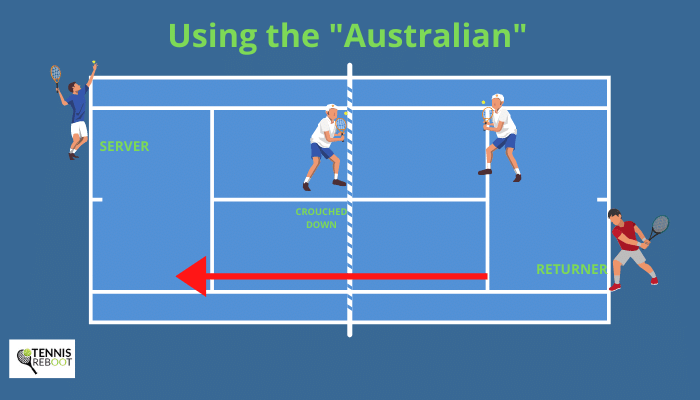
Another effective formation in tennis doubles strategy, the Australian, has the net player and server on the same side of the court.
It’s similar to the I-formation, but a little bit different in that it’s more overt court coverage blocking.
In the I-formation, both players hug the middle. In the Australian formation, both players are on one side.
Seems a little ODD and risky, right?
It is. You’ll be leaving half of the court wide open.
But it’s not all bad or nobody would use it. Before you can completely scrap it as ludicrous, it’s important that you know its advantages:
If the returner has not been showing any inclination to hit down the line, or you know their groundstroke on that side (whether deuce or ad) isn’t that strong, you can force their hand.
If you’re serving on the ad side and have had a hard time dealing with the return to your backhand (if a right-handed player), using this formation will result in a pretty good likelihood that the returner will change direction of their return.
By having both members of the serving team on one side of the court, the returner is more likely to hit to the open court – down the line – which you know isn’t their strongest direction AND might lend itself to YOUR stronger side.
Finding Your Partner
There are many things to consider before committing to a doubles team. First off is skills.
Neither you nor your partner have to be talented geniuses. You just have to find someone whose strengths compliments your weaknesses.
If you both have fantastic serves, but can’t keep a rally going, it’s not the best partnership. It’s a matter of balance.
Second involves personality. A team can have all the talents in the world, but if they don’t see eye to eye or don’t play WITH each other, then there’s no point in playing together.
Lastly, remember there’s no such thing as a perfect partner. Yes, there might be people that you’ll get along with more, but each doubles pair has a unique dynamic.
Keep Working at Doubles Tennis Strategies
Playing doubles tennis might be hard when first starting out, but if you follow these tennis doubles strategies for beginners, you’ll win more points and have so much fun on court. Soon you won’t be a beginner anymore!
Don’t let doubles tennis overwhelm you. It takes some time to be comfortable on court relying on another player, but in time, you’ll love it.
You’ll be winning doubles matches before you know it. Keep practicing and be patient.
Any day on a tennis court beats a day at work!

